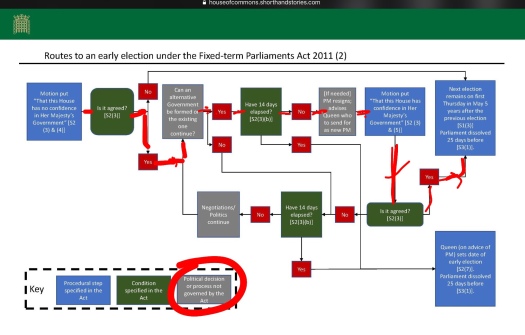Brits love to queue. The UK Parliament is no different, and loves it’s procedures. However, they have changed recently, especially regarding the manner of bringing down a Government. In this post, we attempt to explain how this PM, her government, or even democracy itself, might yet fall victim to this mayhem we call Brexit.
The eyes have it
The UK Parliament runs on procedure, and where none exists, it’s left to “politics”. Rather than bamboozle the reader with a lot of “procedure, in this post we run our eyes over the new procedures, and attempt to give a 5,000 foot overhead view of the path to removing the PM.
May I continue?
After last week’s comedy of “Will they won’t they”, the rebels in the UK Conservative (Tory) Party finally mustered the confidence to bring a leadership challenge. They lost, although in doing so, they clarified the number of Tory MPs who would vote against PM May every day of the week. But still, the press and the faithful all declared the matter closed, and PM May went to Europe to be locked in her limo, safe from those who would gladly see her gone.
May I interject ?
But as we wrote here, this is far from the end of the matter. There is more than one way to skin a PM. Back in 2011 it was decided to clarify the Parliamentary procedures for forcing an early election – the so called “Fixed term Parliaments Act 2011”.
In it, the bill also set two other important forms of Parliamentary rule or proceedure, that of removing the remaining latitude for the Monarch to dissolve Parliament, and the procedure by which Parliament can rid itself of a PM without requiring a General Eleection.
And it seems to us, that this latter process is precisely what is in motion now, with Labour’s motion of no confidence (MoNC).
Perhaps seeing the chaos that Brexit would create, or perhaps just by “coincidence”, the Public Administration and Constitutional Affairs Committee of the Houses of Parliament reviewed these matters and clarified the main two points only last week
In their report, they provided this handy flow chart, explaining how one can get rid of a PM.

As you can see, if the House agrees that it finds no confidence in “HM Government” it allows a cooling off period of 14 days, by which, if confidence is not restored, the PM has to resign. If an alternative PM can be found within the 14 days we go back to the resuming the existing Government, but under a new PM. If not, then a General election occurs.
To follow the chart, we’ve drawn in red, the path to a new PM without a fresh election.
 Note the actual resignation portion is NOT procedural – it’ll be upto the PM to “do the right thing”.
Note the actual resignation portion is NOT procedural – it’ll be upto the PM to “do the right thing”.
However, should she “remain” the process does take over once the 14 days are up and a new election will be called.
So who will decide her fate ?
The MoNC’s brew
Well firstly we have the 100+ Tory MPs who voted against her last week. Surely some of them will muster the courage to do so again?
Secondly there is the opposition, mainly Labour MPs, but including SNP etc. Now it’s far from certain that they would all vote against May’s Government. This is a poison chalice, and many would prefer the Tories to complete their demise by being in charge of the Brexit fiasco “soup to nuts” – recall this was ex-PM Cameron’s idea after all.
Similarly, even Opposition Leader Corbyn has had to be railroaded into raising the Motion of No Confidence (MoNC) – presumably preferring to heckle rather than govern.
The opposition parties are as split as the Tories – with leavers and remainers. Presumably the leave-Labour MPs would prefer to see the Tories stuck with this, and may feel losing PM May now would only result in a second “people’s vote”.
No, we can see the MoNC potentially being quite close if left to the major parties.
Come on Arlene
The one party that is not split, and completely clear on how it would like to see Brexit unfold, is Arlene Foster’s DUP.
And their 10 MPs should be enough to manage both the vote to remove PM May, and (when they switch back) the subsequent vote required to preserve the existing Government run by a new PM.
Enjoy the Silence
So where are the risks?
Well on the basis that Corbyn follows through with his statement of intent to offer a MoNC in the government, and that the Speaker of the House has read the new procedures, we should have a vote quite quickly.
As discussed above, the risk in the first vote is that enough Labour MPs vote to keep May. Given Corbyn’s reluctance to have the MoNC in the first place, he may not enforce the whip, requiring their MPs to vote with the party.
If the initial vote goes against May, then the risk becomes her not resigning. Recall this is not procedure, and if she digs in, forcing the 100 Tories to change their mind and save their skins, then it’s possible after 14 days are up, we go to fresh elections.
Should May resign, then the risk becomes that the Tories can’t find a PM sufficiently satisfactory to Arlene Foster. One that will make sure the Irish backstop does not remain in its current “flexible” form.
If we make it thought all those “ifs” then we find ourselves with the same government with a new PM, but still with the same “Foster Parent”.



I really like your writing style, good info , appreciate it for putting up : D.
LikeLike